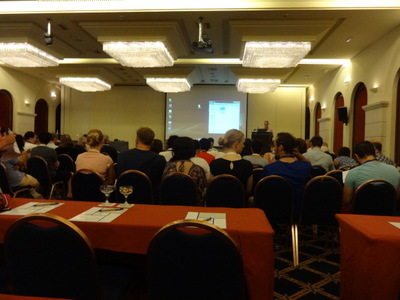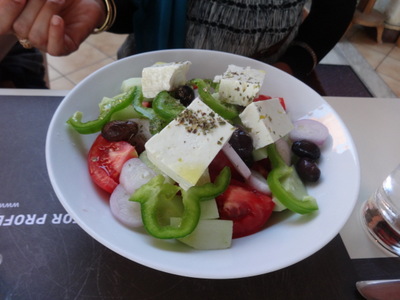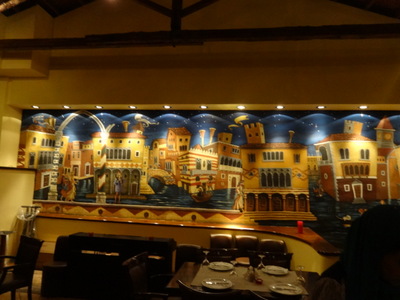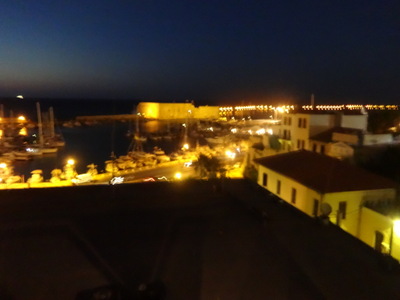
 I had a lazy day and used the time to bring this diary up to date. I started by attending the opening session, just long enough to hear all the welcoming speeches—we usually get the mayor or some such, but not this time.
I had a lazy day and used the time to bring this diary up to date. I started by attending the opening session, just long enough to hear all the welcoming speeches—we usually get the mayor or some such, but not this time.Monday, 4 July 2016, Let the meetings begin!
Written 5 July 2016

 I had a lazy day and used the time to bring this diary up to date. I started by attending the opening session, just long enough to hear all the welcoming speeches—we usually get the mayor or some such, but not this time.
I had a lazy day and used the time to bring this diary up to date. I started by attending the opening session, just long enough to hear all the welcoming speeches—we usually get the mayor or some such, but not this time.
At the left is my view from the back of the lecture hall where the meetings took place. A major good point of the meiofauna meetings is that they are always held in single session—everyone attends (or at least can attend) every talk, and you never have to skip one to hear another.
About 150 chairs were set up, most in rows at the front and a few more at rows of tables across the back, and that accommodated just about everybody. Another advantage of these meetings is that the international meiofauna community is quite small.
At the right is a view down the rows of posters. Except for lunch, the whole meeting is accommodated in two large rooms—this one, in which coffee breaks occupy the far end (where the people are standing), the posters occupy the near end, and the entrance and registration desk are in the middle (the latter out of sight behind the left-hand row of posters), and the lecture hall, directly below. Lunch, which is included in the registration fee (even for me as an "accompanying person") is served buffet style in the hotel's restaurant, at the other end of the lobby.
After the welcoming session, I set up my computer table at the back of the poster area, next to a convenient electrical outlet, and diarized away all morning.

 When the morning sessions ended, at 12:45, we adjourned to the restaurant for lunch. Let me begin with a word about "dakos." Françoise had warned us that we would encounter them everywhere, and she was right. They are served at every meal—breakfast, lunch, and dinner—and are the most popular between-meal snack.
When the morning sessions ended, at 12:45, we adjourned to the restaurant for lunch. Let me begin with a word about "dakos." Françoise had warned us that we would encounter them everywhere, and she was right. They are served at every meal—breakfast, lunch, and dinner—and are the most popular between-meal snack.
A dakos consists of a barley rusk—that is, a piece of dense mixed-grain bread in which barley flour predominates, baked once in loaf form, then sliced and baked again until very hard (not to say petrified)—topped with seasoned grated fresh tomato, crumbled salty cheese, and optionally olives or olive paste. With a little caution, you can avoid breaking your teeth when you bite into it, but with every bite it's a toss-up whether the remaining portion will shatter into six pieces and scatter in all directions, splattering you with tomato juice in the process. They are tasty but not easy to eat. Then you have to pick the bits of barley hull out of your teeth.
As you can see in the left-hand photo, the rusks come in all sizes, but the most common and popular is about the size of a half hamburger bun. The first items on the buffet at every meal are the basket of rusks and the four toppings for them. Here, the two left-hand bowls are filled with green and black olive paste. All the toppings are delicious, but I'd like to put them on a softer piece of bread or at least something crisp rather than hard!

 Here's my plate from the lunch buffet. At six o'clock is a dakos, accompanied by a little heap of green olive paste. To the left of it is a bruschetta topped with lettuce and prosciutto, and to the left of that a pretzel-shaped sesame cookie, under which lurk some chunks of cucumber and tomato and a few pieces of pasta salad. In the center is a little tartlet similar to a dakos but on a crumbly olive-oil-pastry base and sprinkled with oregano. Above that, the fried object is a miniature pork schnitzel (excellent with a squeeze of lemon), which partially obscures a kempap (elongated seasoned grilled meatball of lamb and beef, left) and some chopped grilled vegetables (right). Above those is a slice of white melon. Finally, the cylinder at three o'clock is a syrup-soaked pastry with custard in the center (a galataboreko?). All pretty good, but I think I'll skip the dakos next time.
Here's my plate from the lunch buffet. At six o'clock is a dakos, accompanied by a little heap of green olive paste. To the left of it is a bruschetta topped with lettuce and prosciutto, and to the left of that a pretzel-shaped sesame cookie, under which lurk some chunks of cucumber and tomato and a few pieces of pasta salad. In the center is a little tartlet similar to a dakos but on a crumbly olive-oil-pastry base and sprinkled with oregano. Above that, the fried object is a miniature pork schnitzel (excellent with a squeeze of lemon), which partially obscures a kempap (elongated seasoned grilled meatball of lamb and beef, left) and some chopped grilled vegetables (right). Above those is a slice of white melon. Finally, the cylinder at three o'clock is a syrup-soaked pastry with custard in the center (a galataboreko?). All pretty good, but I think I'll skip the dakos next time.
The buffet also included chicken-lettuce-tomato wraps, French fries, rice pilaf with optional tomato sauce, skewers of tomato and mozzarella, and cheese-filled pastries. And then there was the dessert table, in the right-hand photo, which pretty much speaks for itself.

 After lunch, the participants went back to their talks, and I went back to my computer.
After lunch, the participants went back to their talks, and I went back to my computer.
At the left here is the spread for the afternoon coffee break (largely the same as the one in the morning): bowls of dried fruit, cookies, and sesame candy; chocolate-iced cake; four kinds of uniced cake; and, at the far end, a sliced cylinder of fudge with nuts in it.
At the right is the phalanx of cups, saucers, glasses, urns, bottles, teabags, juice pitchers, sweeteners, etc. awaiting the stampede for coffee.
Near the end of the coffee break, when the rush had died down, one of the waiters, who had seen me sitting in the back of the room all morning, asked me what all these people studied and why. I was just formulating an answer (what is the meiofauna, how large are the animals, where do they live, why are they important to the food chain, why are they good model animals) and trying to put it in words a Greek speaker with shaky English would understand when the bell went for the 4 p.m. lecture, which I wanted to attend. I promised to come back and continue, and I've seen him since but not while both of us had a minute to talk. I hate to lose the opportunity to explain to someone who expresses interest; he presumably votes for the government that funds Greek university research . . .
Once the afternoon's session was over, we agreed to meet with a few friends who were looking for a good restaurant. I wanted to try Veneto, which came well recommended by other friends, and nobody else had a better idea, so I led the way.
We were pretty early, but they were open and were able to accommodate a party of eight on their second-floor terrace overlooking the harbor.

 Among us, we ordered five different things. Our colleague from Baton Rouge and the lady from Italy ordered "shrimps on the grill," which came arranged in this lovely rosette with salad greens in the middle.
Among us, we ordered five different things. Our colleague from Baton Rouge and the lady from Italy ordered "shrimps on the grill," which came arranged in this lovely rosette with salad greens in the middle.

 The Indian lady who lives in Texas ordered one of the two recommended specials of the day: briam. It was a sort of Greek ratatouille with chunks of potato and fried cheese in it.
The Indian lady who lives in Texas ordered one of the two recommended specials of the day: briam. It was a sort of Greek ratatouille with chunks of potato and fried cheese in it.
David and the Japanese guy working in England got the other special: soutzoukakia smirneika. That's Smyrna-style meatball kebabs grilled and then braised in a fresh tomato sauce. It's one of the traditional recipes brought to Crete and mainland Greece when the Turks expelled the entire (mostly Greek) population of Smyrna a hundred years or so ago. I didn't taste the meat, but the sauce was out of this world. I've looked up the recipe. I've gotta try that one at home.

 I thought I was the least adventurous, ordering yet another whole grilled European sea bass, but others at the table thought I was very daring to tackle a whole fish on the bone. I also got leafy salad with my fish, unusual in restaurants around here, where "salad" doesn't usually include leaves.
I thought I was the least adventurous, ordering yet another whole grilled European sea bass, but others at the table thought I was very daring to tackle a whole fish on the bone. I also got leafy salad with my fish, unusual in restaurants around here, where "salad" doesn't usually include leaves.
At the right is a photo of the whimsical mural of Venice on the restaurant's back wall.
 Another pretty blurry night shot—my present camera just doesn't do as good a job in the dark as the last one did. It at least gives you an idea of the view from the restaurant over the harbor and old fort in the late dusk.
Another pretty blurry night shot—my present camera just doesn't do as good a job in the dark as the last one did. It at least gives you an idea of the view from the restaurant over the harbor and old fort in the late dusk.
And the composition of our group gives you an idea of how international the meiofauna community is. The organizers mentioned in the opening session that the 150 or so attendees represent 24 different countries.